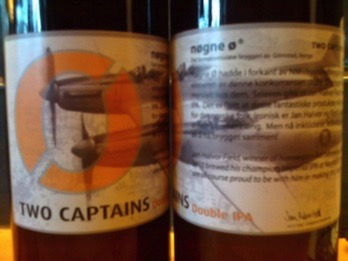Xbeeriment is
the name of a series of fine beers brewed by two Danish fellows, Anders
Østergaard and Thomas Noelgaard, who have been craft brewing since 2005 and 2002,
respectively. Xbeeriment does not have a physical plant, but instead Anders and
Thomas brew their beers mostly at Amager Brewery near Copenhagen.
Black Force One is a hybrid imperial
stout. At 10.4 percent ABV and thoroughly dry hopped with the Cascade variety,
this one promises to be both potent and bittersweet. The version reviewed here
is the Bourbon Barrel Edition, which was matured in a Bourbon cask for several
months before finally being released in late May of 2011. Xbeeriment brewed a
sparse 374 bottles of this edition, and mine was number 118.
Black Force
One pours with a pitch-black color,
accompanied by a distinct mahogany hue where the liquid kisses the side of the
glass. Beige, fluffy, and about a finger high, the well-retained head is characteristic
of an imperial stout, as is the reasonable amount of lacing. Black Force One
has a rich nose that, on the first whiff at least, reminds me of a cross
between a stout and an IPA: Chocolate and roasted malts clearly dominate, but are
nicely supported by a slight citrus smell, undoubtedly from generous use of Cascade
hops. But, upon additional whiffs, this first impression soon confronts a
complexity of other aromas, including the subtle bourbonesque tones of oak and
vanilla, along with the less-than subtle alcohol note. Liquorice and coffee
also linger in the background, but it takes a bit of effort to find them.
Taking a mouth full reveals a full and creamy body and a surprisingly
lively amount of carbonation – a bit too much for a stout in my view. Dominated
by chocolate and roasted malts, the taste closely resembles the aroma, although
I failed to find those citrusy notes that were so obvious in the nose.
Moreover, the bourbon taste is surprisingly and disappointingly weak, although
the vanilla and oak flavors do manage to make an appearance about halfway
through before succumbing to the intensely bittersweet chocolate and coffee
finish. The surprisingly strong alcohol note, even for a 10.4 percenter,
somewhat detracts from the overall flavor harmony.
In short, I expected a bit more from Black Force One, and the price and
exclusivity of the beer certainly raised my expectations of it. Lesson learned:
Don’t let price and exclusivity dictate your expectations. This is not to say
that Black Force One failed in its attempt to produce a variety of remarkable
flavors: In fact, Black Force One did exceedingly well in that regard. Instead,
the predominance of the alcohol note – on the whole – disrupted what would have
otherwise been a harmonious flavor complex, although this is perhaps more of a
preference issue on my part. More objectively, the almost fizzy mouthfeel was a
stark and less than welcomed contrast with the heavy, creamy body, and was certainly
a bit too fizzy for a stout. That said, the bourbonesque tones – even with
their timidity – made Black Force One Bourbon Barrel Edition a genuine treat. No
regrets here, and my hats off to Xbeeriment for brewing it! I’m glad to have
tried it and look forward to reviewing the next Xbeeriment – Barack.
Links













